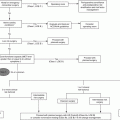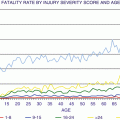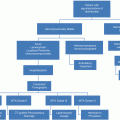Fig. 28.1
Incidence of gunshot wounds stratified by age groups in 98,242 hospital admissions with gunshot injuries (Reproduced, with permission, from the author)
Suicides play a major role in penetrating trauma in the elderly, and the incidence increases with age. Self-inflicted gunshot wounds are responsible for 29.2 % of firearm injuries in the age group 55–64 years, 46.2 % in the group of 65–74 years, and 51.5 % in the group ≥75 years old [2] (Table 28.1). Attempted suicide in the elderly is a well-known public health problem in western societies. Reasons include chronic illness and depression. The Center of Disease Control and Prevention reports an overall incidence of suicides of 11/100,000 in the general population and 14/100,000 in the age group ≥65 years [3]. In urban settings the suicide rate is even higher. Demetriades et al. [4] in an analysis of trauma deaths in the county of Los Angeles reported that in Caucasian males ≥65 years of age, the suicide rate by penetrating trauma was 29.5/100,000. The suicide rate by a penetrating mechanism was 9.5/100,000 in the age group >60 years, as compared to 5.0/100,000 in the age group 15–34 years. Firearms were used in more than 80 % of suicides [4]. The body area injured in penetrating trauma in elderly patients is determined to a significant extent by the intent of the injury. In self-inflicted gunshot wounds in the age group ≥65 years, the head is the most commonly injured anatomical area (54.2 %), followed by the chest (13.5 %) and the abdomen (8.2 %). In patients with assault-related injuries, the abdomen and chest are the most commonly injured anatomical areas (21.6 and 21.4 %, respectively), followed by the extremities (16.9 %) and head (15.9 %) [2].
Table 28.1
Intent of injury in gunshot wounds stratified by age
Intent of injury | 66–64 years | 65–74 years | ≥75 years | p-value |
|---|---|---|---|---|
N = 1,676 | N = 727 | N = 787 | ||
Assault | 804 (48.0 %) | 336 (46.2 %) | 444 (56.4 %) | <0.001 |
Self-inflicted | 489 (29.7 %) | 232 (31.9 %) | 225 (28.6 %) | <0.001 |
Unintentional | 268 (16.0 %) | 117 (16.1 %) | 77 (9.8 %) | <0.001 |
Physiological Changes of Aging
Significant physiological changes which occur with aging may affect the clinical presentation of the elderly patient with penetrating trauma. The cardiovascular system becomes less responsive to endogenous catecholamines, which normally increase in response to traumatic stress. In addition, many elderly patients are on beta blockers or cardiac medications, which blunt the tachycardic response following blood loss and may result in hypotension and tissue hypoperfusion much earlier than in younger patients. The commonly used definition of hypotension as a systolic blood pressure <90 mmHg is highly inaccurate in the elderly, who are often normally hypertensive. A “low normal” blood pressure in these patients may be a hypoperfusion condition and may give a false sense of security to the inexperienced physician.
Heffernan et al. [7] demonstrated increased mortality in elderly trauma patients (≥65 years) when the systolic blood pressure was less than 110 mmHg, while in young patients, the increased mortality was observed only when the systolic blood pressure was <95 mmHg.
Many elderly patients are on diuretic medications, and many patients have a contracted intravascular volume. Modest blood loss in these patients may cause severe hypotension. Finally, due to the limited cardiac reserve and atherosclerotic disease, the safety margin between hypovolemia and fluid overload with cardiac failure is narrow. Early, advanced cardiac monitoring is essential in order to avoid this problem. Injured atherosclerotic vessels cannot constrict effectively, and bleeding may be more severe and last longer compared to younger injured patients.
The respiratory physiological reserve also deteriorates with aging, and these changes include increased dead space and decreased compliance and PaO2. Elderly trauma patients with even modest chest trauma may decompensate rapidly and unexpectedly, often during CT scan evaluation or while being transported. Therefore, early intubation is advisable in patients with borderline respiratory function or hemodynamic instability.
Aging also results in a reduction of the kidney mass, as well as the efficiency of the glomerulus and ability to concentrate urine. Elderly patients are at increased risk of acute kidney injury from hypotension, intravenous radiological contrast, and nephrotoxic drugs.
Finally, loss of effective thermoregulation is another significant physiological change which occurs with aging. Elderly trauma patients become hypothermic even after modest trauma, especially with head injury or blood loss. Hypothermia aggravates bleeding due to coagulopathy which then increases mortality.
Initial Evaluation and Management
Due to the major physiological changes observed with aging, often impacted by cardiac medications, elderly patients need to be monitored closely and carefully resuscitated. The usual hemodynamic criteria used for trauma team activation (systolic BP <90 mmHg or heart rate >120/min) are unreliable in the elderly. Patients who meet the criteria for trauma team activation receive the highest level expert consultation early with continuous monitoring and should have priority for radiological investigations, admission to the ICU, and operative interventions. Thus, misleading admission vital signs in the elderly may delay the activation of the trauma team with negative consequences on outcome.
The poor sensitivity of the initial vital signs as a criterion for activating the highest level of trauma response was demonstrated in a large study from Los Angeles [5]. In a study of 883 trauma patients ≥70 years old, 63 % of victims with severe trauma (ISS >15) and 25 % of victims with critical injuries (ISS >30) did not meet the usual blood pressure and heart rate criteria for the highest level of trauma team activation. The mortality rate in the 660 patients who did not meet the activation criteria was 16 %. The study concluded that (a) elderly trauma patients have a high mortality, even with minor and moderate injuries; (b) a significant number of elderly patients with severe trauma do not meet the standard criteria for trauma team activation; and (c) age ≥70 years alone should be a criterion for trauma team activation, irrespective of vital signs [5]. These findings resulted in a change of the trauma team activation protocol at the LAC + USC Trauma Center, to include age ≥70 years. In addition, the new protocol required early, advanced cardiac monitoring, early endotracheal intubation in the emergency department, and ICU admission after even minor injury in all patients older than 70 years. A follow-up study showed that the new protocol improved survival and functional outcomes. The mortality in patients with ISS >15 was reduced from 54 to 34 % (p = 0.003), and there was a trend toward lower permanent disability (17 % vs. 12 %, NS) [6].
In a recent study from Rhode Island Hospital, the authors concluded that “normal presenting vital signs are unreliable in geriatric blunt trauma victims.” The study reported that mortality increased considerably with systolic blood pressure <110 mmHg in the geriatric patients but not until a systolic blood pressure of <95 mmHg in the young patients. Similarly the mortality increased for heart rate >90 beats per minute in the elderly but not until a heart rate >130 in young patients [7].
A recent study from the state of Florida showed that elderly trauma patients transported to a trauma center had significantly higher survival than patients transported to non-trauma centers [8].
In the emergency department a detailed history should be obtained, if necessary by calling a close family member or their nursing facility. Many medications, often taken by the elderly, such as beta blockers, cardiac medications, diuretics, anticoagulants, and antiplatelet agents, can affect the clinical presentation, the degree of bleeding, and ultimately the outcome. Reversal of anticoagulation or antiplatelet therapy may be needed even before any laboratory results become available.
The primary survey described in the ATLS manual should be followed, but more aggressively than in younger patients. The airway should be protected early, even after moderately injury with normal vital signs and SaO2, because of the frequent unexpected respiratory deterioration in many of these patients. Dentures should be removed. Airway establishment in the elderly may be technically more challenging than in young patients, because of degenerative changes in the cervical spine.
The cardiovascular evaluation should always include an EKG to assess for any underlying cardiac problems. Modern methods of noninvasive cardiac monitoring are now available and can be used in the emergency department to monitor the cardiac output and tissue perfusion. Bioimpedance technology has been shown to be reliable in elderly critically ill patients [9] and can identify any cardiac dysfunction or tissue hypoperfusion early. Bleeding in the elderly is usually more severe and lasts longer than in young patients because of atherosclerosis and anticoagulation or antiplatelet therapy. Interventional angio-embolization or operative intervention should be considered earlier than in young patients with similar injuries. The volume and rate of intravenous fluid administration should be monitored closely, because the physiologic margin between hypovolemia and overloading and pulmonary edema is very narrow. Central venous pressure or noninvasive volume status monitoring should be used liberally.
Stay updated, free articles. Join our Telegram channel

Full access? Get Clinical Tree






